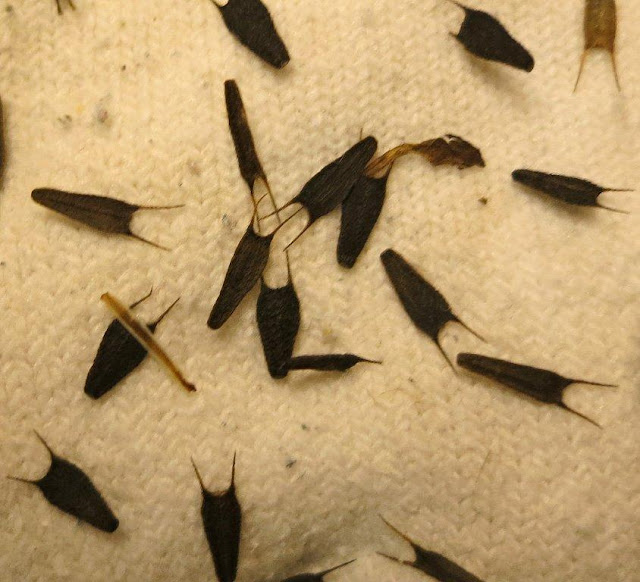That, of course, served the plants' interests extremely well, since our actions helped to spread their range, avoiding competition with the parent and other plants in their immediate area.
Recently I've started to learn to identify more plants and in the process have found out, in some cases for the first time, where some of these "burs" come from.
At the top of the sock are the hooked burdock burs which are supposedly the inspiration for Velcro®. Each bur contains the small seeds shown in the lower right:
There are several species of burdock, all native to the old world and widely distributed. The plant's enormous leaves make it nearly unmistakable:
Here is a picture of burdock in bloom:
There are 7 species of agrimony that are native to North America and the plant is reported to have a variety of medicinal uses. A member of the rose family, it has small yellow flowers and compound leaves. Here is a picture of the plant showing the flower stalk bearing the burs after blooming:
Here is a close-up view, and notice how the burs are angled down, the better to snag on a passing mammal:
Next is cocklebur, a member of the aster family.
It is found mostly along streams and in wet areas. Each football-shaped cocklebur fruit contains two seeds.
It has large coarse leaves like burdock, but in general the plant is much smaller.
Last but not least are the seeds of beggarticks or sticktights.
These come from plants in the genus Bidens and have a wide variety of common names. There are about 200 species of Bidens, and they occur all over the world. Some common members of the genus are not at all showy, with no petals or ray flowers:
If you have ever had to cut any of these burs out of your dog's hair or tried to pick one out of your carpet you can really appreciate their tenacity. Plants whose seeds stick to clothing, fur or feathers are termed zoochorous and they have managed to exploit this characteristic to spread all over the world.
A few posts back I wrote about the huge Pleistocene mammals that roamed Ohio just 13,000 years ago, and postulated that they probably had lice and fleas. Just think about what else they were carrying around in all that fur!













I remember acquiring all manner of burs at Girl Scout camp Happy Hollow in west central Ohio. I never learned anything about all those annoying hitchikers until now. Thank you! Very interesting!
ReplyDeleteLoved your sock illustration. :)
ReplyDeleteDeb
In Albania this plant known as small burdock.
ReplyDeletei hated reading that
ReplyDeleteNothing like an ad that doesn't belong...
ReplyDeleteReally a nice illustration of seed dispersal...just great for folks of any age and illustrates some really cool co-adaptations like seed coat elaborations that enable plants to attach to animals for dispersal...such a wonderfully creative illustration!
ReplyDeleteYeah the friggin ad sucks...
We call them "boosies." Are we alone?
ReplyDeleteGreat read, thank you
ReplyDeleteNice read. Had them stuck to me and my pets all the time growing up in California.
ReplyDeleteEnjoyed identifying my hitchhikers from yesterday’s yard work. Who would have thought the day before the election they are known as Biden’s! Thank you, well done.
ReplyDelete